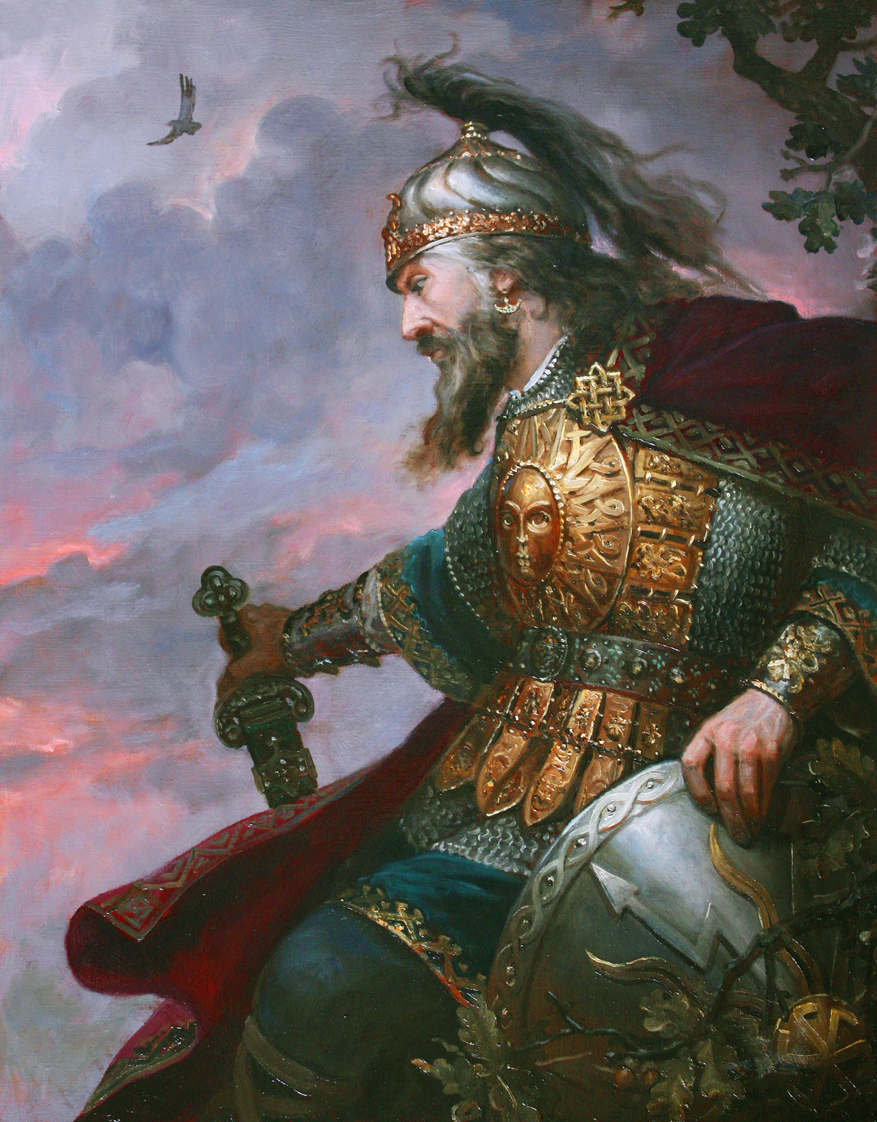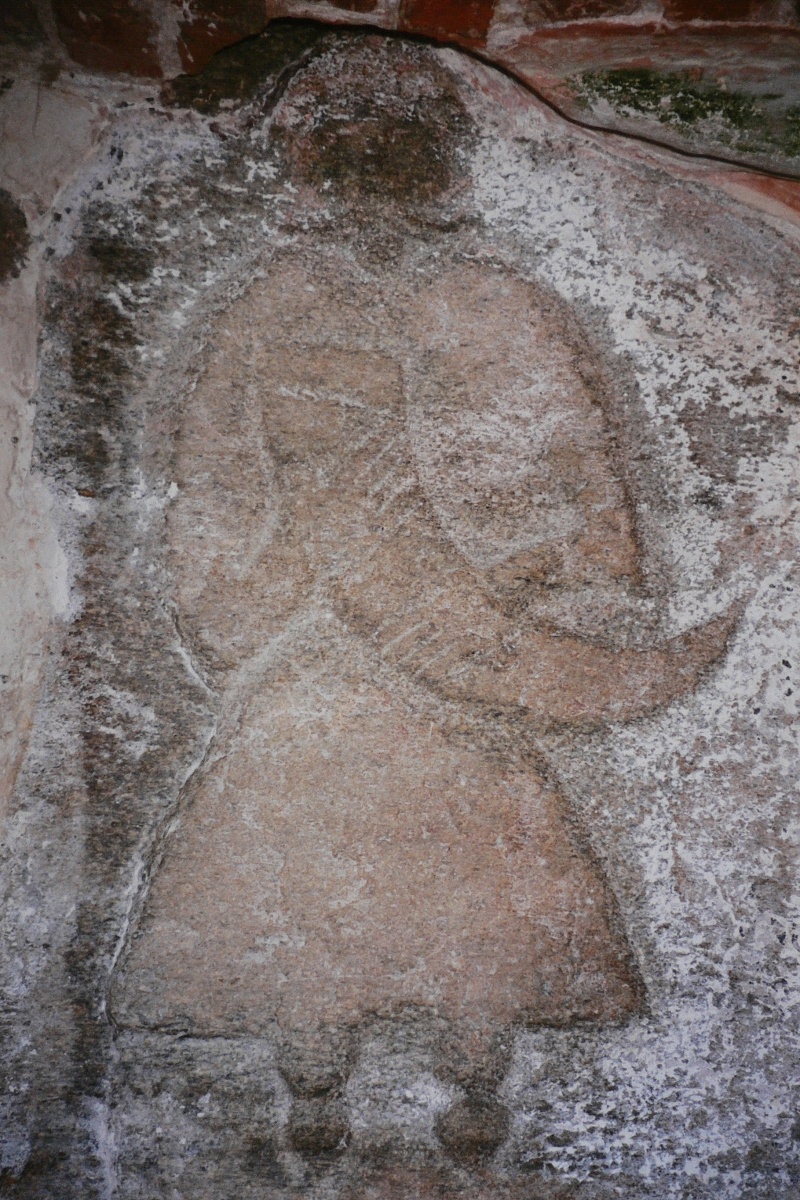|
Ognyena Maria
{{More citations needed, date=November 2022 In Slavic mythology, Ognyena Maria (literally "Fiery Mary") is a fire goddess who is the sister and assistant of the thunder god, Perun. Ognyena Maria originates as a conflation of the figures of Margaret the Virgin and the Virgin Mary, both regarded as sisters of Saint Elias. This divinity also appears with southern Slavs, and is usually considered to be the sister of the thunder god/saint.Petrovitch, Woislav M.; Karadzhic, Vuk Stefanovic. Hero tales and legends of the Serbians'. New York: Frederick A. Stokes company. 915p. 15. She was also associated with rain or the sea, or with Lazarus (Марина Лазоревая) and azure flashes of lightning. Ognyena Maria’s feast in the folk calendar of the Slavs is on July 17, on the Julian calendar (around 30 July). Belarus In Belarus, she is prayed towards for healing from ailments: "Добры вечар, цёмна ноч! На табе, вада, маю бяду, а мне маё ... [...More Info...] [...Related Items...] OR: [Wikipedia] [Google] [Baidu] |
Rusalka
In Slavic folklore, the rusalka (plural: rusalky/rusalki; ; pl, rusałka}) is a typically feminine entity, often malicious toward mankind and frequently associated with water, with counterparts in other parts of Europe, such as the French Melusine and the Germanic Nixie (water spirit), Nixie. Folklorists have proposed a variety of origins for the entity, including that they may originally stem from Slavic paganism, where they may have been seen as benevolent spirits. Rusalki appear in a variety of media in modern popular culture, particularly in Slavic language-speaking countries, where they frequently resemble the concept of the mermaid. In northern Russia, the rusalka was also known by various names such as the Vodyanoy #Vodyanitsa, vodyanitsa (or vodyaniha/vodyantikha; russian: водяни́ца, водяни́ха, водянти́ха ; Literal meaning, lit. "she from the water" or "the water maiden"), kupalka (russian: купа́лка; "bather"), shutovka (russian: шу� ... [...More Info...] [...Related Items...] OR: [Wikipedia] [Google] [Baidu] |
Slavic Goddesses
The pagan Slavs were polytheistic, which means that they worshipped many gods and goddesses. The gods of the Slavs are known primarily from a small number of chronicles and letopises, or not very accurate Christian sermons against paganism. Additional, more numerous sources in which Slavic theonyms are preserved include names, proper names, place names, folk holidays, and language, including sayings. Information about Slavic paganism, including the gods, is scarce because Christian missionaries were not very interested in the spiritual life of the Slavs. Also, no accounts written down directly by the pagan Slavs exist. During the Christianization missions, the deities, on the one hand, were demonized to deter from worshipping them, on the other hand, their characteristics and functions were assumed by the saints, which was supposed to make the new religion less alien. Common Slavic deities Because of the small number of sources, there is no consensus among scholars of Slavic ... [...More Info...] [...Related Items...] OR: [Wikipedia] [Google] [Baidu] |
Institute For Slavic Studies Of The Russian Academy Of Sciences
The Institute for Slavic Studies of the Russian Academy of Sciences (Russian: Институт славяноведения РАН) is an integral part of the Historical and Philological Studies Department of the Russian Academy of Sciences. It is a unique Russian academic institution focused on comprehensive studies of Slavic history, culture, literature, and languages. The Institute carries on the traditions of Russian Slavic scholars that have evolved over the last two centuries. History The Institute was founded in 1947 as the Institute for Slavic and Balcan Studies of the Academy of Sciences of the USSR. Since 1997, the Institute has its current name. Amongst the researchers of the Institute were Academicians of the RAS: Yulian Bromley, Nikolay Derzhavin, Boris Grekov, Gennady Litavrin, Dmitry Markov, Leonid Milov, Sergey Obnorsky, Vladimir Picheta, Yury Pisarev, Mikhail Tikhomirov, Nikita Tolstoy, Vladimir Toporov, and Oleg Trubachyov; Corresponding Members of th ... [...More Info...] [...Related Items...] OR: [Wikipedia] [Google] [Baidu] |
Crop Yield
In agriculture, the yield is a measurement of the amount of a crop grown, or product such as wool, meat or milk produced, per unit area of land. The seed ratio is another way of calculating yields. Innovations, such as the use of fertilizer, the creation of better farming tools, new methods of farming and improved crop varieties, have improved yields. The higher the yield and more intensive use of the farmland, the higher the productivity and profitability of a farm; this increases the well-being of farming families. Surplus crops beyond the needs of subsistence agriculture can be sold or bartered. The more grain or fodder a farmer can produce, the more draft animals such as horses and oxen could be supported and harnessed for labour and production of manure. Increased crop yields also means fewer hands are needed on farm, freeing them for industry and commerce. This, in turn, led to the formation and growth of cities, which then translated into an increased demand for foodstuff ... [...More Info...] [...Related Items...] OR: [Wikipedia] [Google] [Baidu] |
Slava (tradition)
Slava ( sr-Cyrl, Слава, lit=Glory, Celebration, ) is a tradition of the ritual of glorification of one's family's patron saint, found mainly among Serbian Orthodox Christians. The family celebrates the Slava annually on the saint's feast day. In 2014 it was inscribed in UNESCO Intangible Cultural Heritage Lists of Serbia. Overview The Slava is a family's annual ceremony and veneration of their patron saint. It is a tribute to the family's first ancestor who was baptized into Christianity, with its presiding saint. The family's patron saint is passed down from father to son and only males are allowed to carry out the Slava's rituals. Upon marriage, women typically adopt the patron saint of their spouse although it is not uncommon for them to continue celebrating their native family's saint as well (in which case the secondary one is known as ''preslava''). Close friends and family gather at the home for a ritual feast. Although a religious ceremony for the purpose of saint v ... [...More Info...] [...Related Items...] OR: [Wikipedia] [Google] [Baidu] |
Republika Srpska
Republika Srpska ( sr-Cyrl, Република Српска, lit=Serb Republic, also known as Republic of Srpska, ) is one of the two Political divisions of Bosnia and Herzegovina, entities of Bosnia and Herzegovina, the other being the Federation of Bosnia and Herzegovina. It is located in the north and east of the country. Its largest city and administrative centre is Banja Luka, lying on the Vrbas (river), Vrbas river. Republika Srpska was formed in 1992 at the outset of the Bosnian War with the stated intent to safeguard the interests of the Serbs of Bosnia and Herzegovina. The war saw the Ethnic cleansing in the Bosnian War, expulsion of the vast majority of Croats of Bosnia and Herzegovina, Croats and Bosniaks from the territory claimed by Republika Srpska and an inflow of Serbs expelled from Federation of Bosnia and Herzegovina. Following the Dayton Agreement of 1995, Republika Srpska achieved international recognition as an entity within Bosnia and Herzegovina. ... [...More Info...] [...Related Items...] OR: [Wikipedia] [Google] [Baidu] |
Serbs Of Bosnia And Herzegovina
The Serbs of Bosnia and Herzegovina ( sr-Cyrl, Срби у Босни и Херцеговини, Srbi u Bosni i Hercegovini) are one of the three constitutive nations (state-forming nations) of the country, predominantly residing in the political-territorial entity of Republika Srpska. In the other entity, Federation of Bosnia and Herzegovina, Serbs form the majority in Drvar, Glamoč, Bosansko Grahovo and Bosanski Petrovac. They are frequently referred to as Bosnian Serbs ( sr, босански Срби, Bosanski Srbi) in English, regardless of whether they are from Bosnia or Herzegovina. They are also known by regional names such as ''Krajišnici'' ("frontiersmen" of Bosanska Krajina), ''Semberci'' ( Semberians), ''Bosanci'' ( Bosnians), ''Birčani'' (''Bircians''), Romanijci (''Romanijans''), ''Posavci'' (Posavians), ''Hercegovci'' (Herzegovinians). Serbs have a long and continuous history of inhabiting the present-day territory of Bosnia and Herzegovina, and a long histo ... [...More Info...] [...Related Items...] OR: [Wikipedia] [Google] [Baidu] |
Bosnia And Herzegovina
Bosnia and Herzegovina ( sh, / , ), abbreviated BiH () or B&H, sometimes called Bosnia–Herzegovina and often known informally as Bosnia, is a country at the crossroads of south and southeast Europe, located in the Balkans. Bosnia and Herzegovina borders Serbia to the east, Montenegro to the southeast, and Croatia to the north and southwest. In the south it has a narrow coast on the Adriatic Sea within the Mediterranean, which is about long and surrounds the town of Neum. Bosnia, which is the inland region of the country, has a moderate continental climate with hot summers and cold, snowy winters. In the central and eastern regions of the country, the geography is mountainous, in the northwest it is moderately hilly, and in the northeast it is predominantly flat. Herzegovina, which is the smaller, southern region of the country, has a Mediterranean climate and is mostly mountainous. Sarajevo is the capital and the largest city of the country followed by Banja Luka, Tu ... [...More Info...] [...Related Items...] OR: [Wikipedia] [Google] [Baidu] |
Serbia
Serbia (, ; Serbian language, Serbian: , , ), officially the Republic of Serbia (Serbian language, Serbian: , , ), is a landlocked country in Southeast Europe, Southeastern and Central Europe, situated at the crossroads of the Pannonian Basin and the Balkans. It shares land borders with Hungary to the north, Romania to the northeast, Bulgaria to the southeast, North Macedonia to the south, Croatia and Bosnia and Herzegovina to the west, and Montenegro to the southwest, and claims a border with Albania through the Political status of Kosovo, disputed territory of Kosovo. Serbia without Kosovo has about 6.7 million inhabitants, about 8.4 million if Kosvo is included. Its capital Belgrade is also the List of cities in Serbia, largest city. Continuously inhabited since the Paleolithic Age, the territory of modern-day Serbia faced Slavs#Migrations, Slavic migrations in the 6th century, establishing several regional Principality of Serbia (early medieval), states in the early Mid ... [...More Info...] [...Related Items...] OR: [Wikipedia] [Google] [Baidu] |
Elijah's Day
Elijah ( ; he, אֵלִיָּהוּ, ʾĒlīyyāhū, meaning "My God is Yahweh/YHWH"; Greek form: Elias, ''Elías''; syr, ܐܸܠܝܼܵܐ, ''Elyāe''; Arabic: إلياس or إليا, ''Ilyās'' or ''Ilyā''. ) was, according to the Books of Kings in the Hebrew Bible, a prophet and a miracle worker who lived in the northern kingdom of Israel during the reign of King Ahab (9th century BCE). In 1 Kings 18, Elijah defended the worship of the Hebrew God over that of the Canaanite deity Baal. God also performed many miracles through Elijah, including resurrection, bringing fire down from the sky, and entering heaven alive "by fire". 2 Kings 2:11 He is also portrayed as leading a school of prophets known as "the sons of the prophets". Following his ascension, Elisha, his disciple and most devoted assistant, took over his role as leader of this school. The Book of Malachi prophesies Elijah's return "before the coming of the great and terrible day of the ", making him a harbinger ... [...More Info...] [...Related Items...] OR: [Wikipedia] [Google] [Baidu] |
Slavic Mythology
Slavic mythology or Slavic religion is the religious beliefs, myths, and ritual practices of the Slavs before Christianisation, which occurred at various stages between the 8th and the 13th century. The South Slavs, who likely settled in the Balkan Peninsula during the 6th–7th centuries AD, bordering with the Byzantine Empire to the south, came under the sphere of influence of Eastern Christianity, beginning with the creation of writing systems for Slavic languages (first Glagolitic, and then Cyrillic script) in 855 by the brothers Saints Cyril and Methodius and the adoption of Christianity in Bulgaria in 863. The East Slavs followed with the official adoption in 988 by Vladimir the Great of Kievan Rus'. The West Slavs' process of Christianization was more gradual and complicated. The Moravians accepted Christianity as early as 831, the Bohemian dukes followed in 845, Slovaks accepted Christianity somewhere between the years 828 and 863, but the Poles accepted it much later ... [...More Info...] [...Related Items...] OR: [Wikipedia] [Google] [Baidu] |




